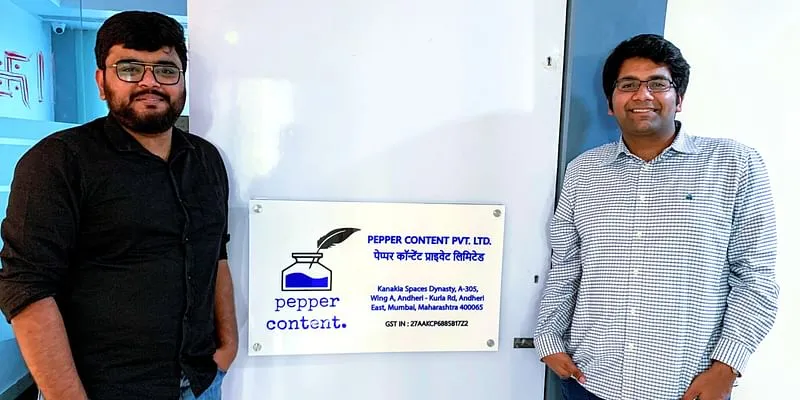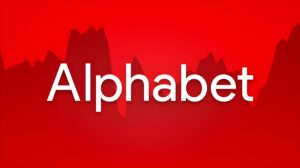The phrase “content is king” might sound clichéd, but it is core to video, text, images, or likely any other form that drives marketing today. To leverage the power of content, Anirudh Singla, Adit Mittal, Rishabh Shekhar, and Parv Panthari started Pepper Content from their hostel rooms at BITS Pilani in 2017.
The idea was to help companies produce better content through a network of freelancers, who are skilled at what they do and want to do it on their terms.

Founders of Pepper Content – Rishabh and Anirudh
As an on-demand content marketplace Pepper Content matches projects around content creation in text, design, and languages with the best-fit content creators.
“Our technology matches the project attributes to creator attributes and enables content operations seamlessly,” says Anirudh. “We have been able to achieve operational scalability that has allowed us to create over 200,000 content pieces until now.”
A product-first approach
Anirudh explains that Pepper follows a product-led approach focused on building the most efficiently managed marketplace — think Uber, but for content creation — with sophisticated software tools that help businesses manage their content workflows and allow creators to control their professional lives.
“While companies have been creating and outsourcing content for decades now, nobody has tried to use deep technology to make the entire process seamless and effective,” says Anirudh. “You still need to post requirements, bid for projects and choose from a large list of bidders, and negotiate pay, making it cumbersome and, frankly, unscalable.”
With a product-first thinking Pepper simplifies this workflow, the goal being to reduce a usually long-drawn-out process to two steps: choose what you want and have it delivered with quality and speed.
Pepper’s platform delegates all the management aspects of a marketplace to smart algorithms that:
- Find the best match between projects and creators based on parameters such as industry, language, and specialisation.
- Run agile workflows to get content delivered on time.
- Enhance quality through strong editorial checks using tools integrated with the platform and through a freelance editorial talent network.
“We launched Peppertype a few months back,” says Anirudh. “It is an AI (artificial intelligence)-assisted content creation platform, where we have seen more than 8,000 sign-ups and $5,000 in ARR (annual recurring revenue) already.”
According to him, Peppertype enables businesses and creators to generate short-form content in seconds and is built on top of AI-powered language tool GPT-3. He says a deep understanding of the content ecosystem allows the Pepper team to leverage what customers want and provide a deeper interconnected value chain offering of not only generating ideas through Peppertype, but also creating content through the marketplace.
“We are moving from being just a managed marketplace to a SaaS (software as a service)-enabled marketplace that allows us to solve bigger problems with regard to content creation, strategy, and distribution,” says Anirudh.
Creating a self-serve marketplace
A self-serve marketplace model on Pepper allows businesses to directly order content from the platform without any human intervention, thus reducing the time taken for project delivery.
“We solve the problem of having to source quality content creators and are able to create content at scale with faster turnaround times,” says Anirudh. “Businesses now have clear visibility of the status of each content piece and are notified once it’s done. They don’t need to spend unnecessary time to find the right creator or deal directly.”
This approach, he says, has so far generated over Rs 4.5 crore in earnings for creators, offering value for them and customers alike.
For growth-stage companies with more customer requirements, “Pepper for enterprises” enables more customisation and better customer success support.
“With creators, we have enabled easy integrations like WhatsApp, email, along with our web interface, where they can get projects and choose to accept or reject them at their convenience,” says Anirudh. “We are creating assistive tools that allow them to create higher-quality content on a much faster basis embedded on the platform.”
While more than 45,000 creators have applied to create content for Pepper Content, Anirudh says the team works with only the top 10 percent through structured onboarding processes.
In the initial days, the team was building the writer ecosystem, but it soon realised there was a huge market in categories such as design, language, and video. That’s where Pepper is evolving, he says.
Building from scratch
Pepper’s first products were hyper-customised sheets with deep linking of formulae and scripts that enabled the team to piece together workflows.
“We started building Pepper in college and we were non-tech founders and hence for us it took some hiccups, roadblocks, and mistakes to finally create the first version of our web product in 2019,” says Anirudh.
For this, the team worked on more than 25,000 content pieces on Google sheets and docs before converting them into product form for every aspect of the operations journey — from onboarding customers and creators to enabling assignments to creators.
The team considered every possible use case or edge case in the customer flow journey and worked on what needed to be done to scale this operationally.
“It was like this for more than a year till we realised that we needed more technology on top of it,” says Anirudh. “Once we rolled out the product, customers were in awe of something so customised and detailed in the content space. Post that, they just threw 8-10 more problem statements they had in the space because their perception had changed about technology bringing innovation in the space and our product had shown how it could be done.”
The differentiating factor
According to MarketsandMarkets, the global content marketing tech market is projected to touch $9.59 billion by 2023 at a compound annual growth rate of 18.4 percent in the forecast period 2018-2023, with 2017 as the base year when the market size was $3.42 billion.
Apart from Pepper, there are others like Fiverr, Upwork, and content services providers such as White Panda and WriterAccess. Anirudh says that unlike other marketplaces, Pepper gets content facilitated with a different approach.
“We are not a listing platform or an open marketplace platform. We manage the entire content operations, right from the ordering flow to end-to-end delivery. This enables strong customer experience and trust on both sides of our networks: Customers trust the quality of the marketplace and offerings Pepper provides, while creators don’t need to worry about not getting payments on time or dealing with a lot of operational work to get more assignments.”
The focus on product and customer feedback has helped Pepper Content grow, says Anirudh. As the platform works in a services-heavy industry, where people are used to a certain way of working, forming new habits and changing people’s perception of processes and product adoption are difficult, he says.
“Having the support of our customers and creators played a critical role in building a scalable minimum viable product.”
Building strategy with AI
The AI-assisted content creation platform, Peppertype, was built within five weeks from ideation to launch, says Anirudh. “That’s the product-first enablement we have reached. Currently, of the total team size, 45 percent is product and tech, signalling our company’s product-first DNA.”
Rohit Agarwal, Head of Product at Pepper Content, says the team realised that AI has a big role to play in the market and hence focused on figuring out solutions that automated most of the operational work and brought smarter thinking into processes.
“Examples include Peppertype, our recommendation engine for assigning projects to creators, and many more that allowed us to increase the efficiency of our platform by a significant margin,” says Rohit.
The idea, he says, stemmed from an internal brainstorming session in December 2020, during which the team discussed that while Pepper solved the “how” of content creation, businesses at times needed help with strategy.
“Clients were repeatedly asking ‘What should we write about next?’ or ‘How do I grow engagement on Twitter?’,” says Rohit. “We decided to look to answering these questions as well. In June 2020, OpenAI released GPT-3, a highly evolved AI-powered language tool, and that’s where we saw the possibilities of an answer to our questions. By building a layer over GPT-3, we could create a tool that could change the game when it comes to content strategy and ideation.”
The team says the product has more than 6,000 sign-ups on the wait list. As of March 1, 2021, more than 30,000 copies were created using Peppertype, with over 35 percent of users from outside India.
Marrying tech and content
Given the encouraging response for the AI-enabled Peppertype, Rohit says there is huge potential in making it a global platform.
“We crossed $600 MRR (monthly recurring revenue) within four days of launching the product and are bullish about its long-term prospects,” he says. “We are building for the world from India.”
He says the team will soon launch a new way to “get content done”, for which he cites an example: Imagine ordering content the same way as sunglasses.
Stressing that the creator economy is just taking off in India, Anirudh says the creative potential in the country is huge.
“Globally, content marketing is a $400-billion opportunity and we realised early on that the entire ecosystem is still doing things in a very unstructured and inefficient manner,” he says.
“Technology could give a massive boost to the creative and marketing ecosystem and enablers like Pepper can allow brands to source higher-quality talent through our on-demand platform, while creators can earn meaningful income by doing work that they love at their own time and choice,” says Anirudh.

![You are currently viewing [Product Roadmap] How Pepper Content leverages deep tech to power content creation](https://blog.digitalsevaa.com/wp-content/uploads/2021/04/PRM-1617704705153.png)








